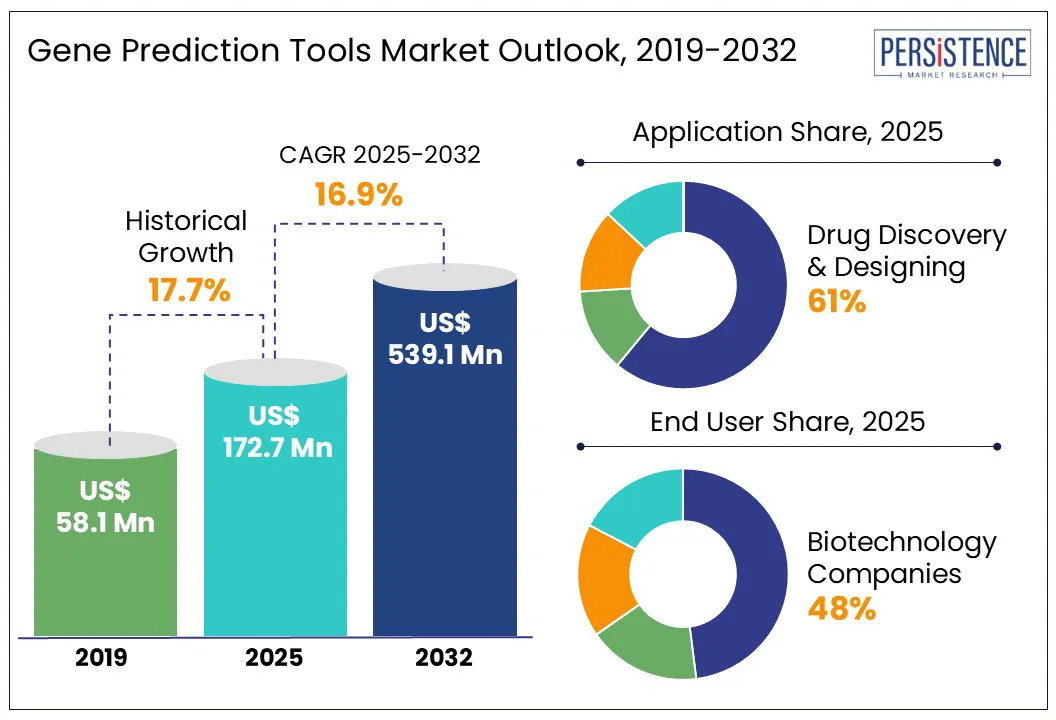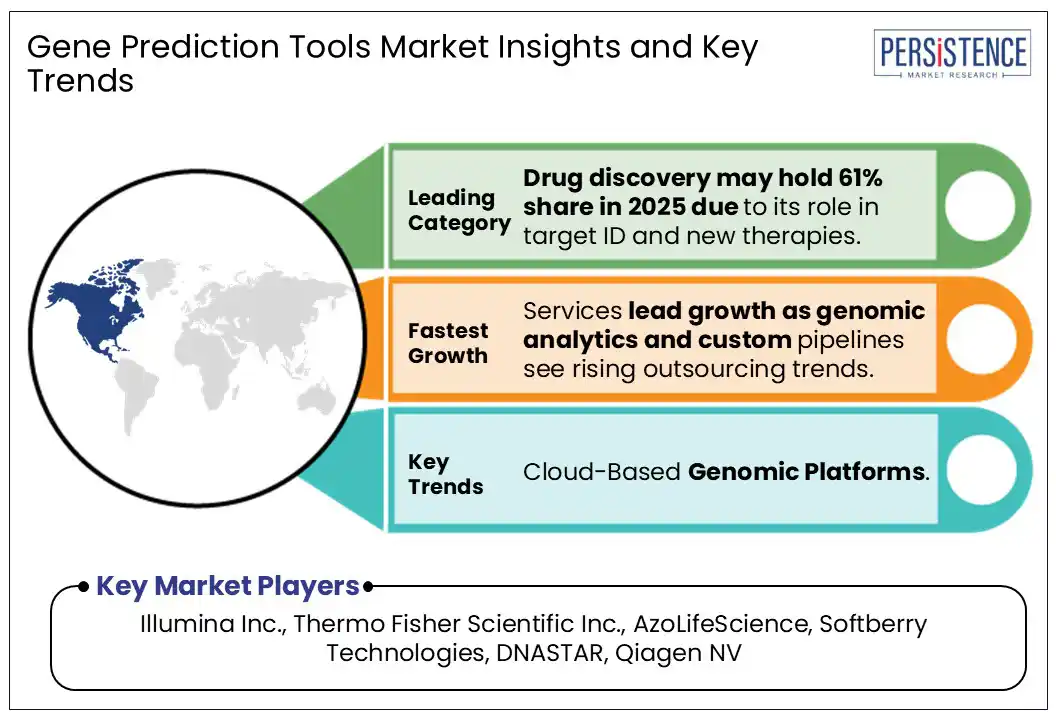ID: PMRREP34771| 177 Pages | 24 Jun 2025 | Format: PDF, Excel, PPT* | Healthcare

Global prediction tools market size is likely to be valued at US$ 172.7 Mn in 2025 and is estimated to reach US$ 539.1 Mn by 2032, growing at a CAGR of 17.7% during the forecast period 2025-2032.

Key Highlights of the Market
|
Market Attributes |
Key Insights |
|
Market Size (2025E) |
US$172.7 Mn |
|
Projected Market Value (2032F) |
US$539.1 Mn |
|
Global Market Growth Rate (CAGR 2025 to 2032) |
17.7% |
|
Historical Market Growth Rate (CAGR 2019 to 2024) |
16.9% |
|
Region |
Market Share in 2025 |
|
North America |
37.4% |
North America is leading the gene prediction tools market due to its strong genomics research ecosystem, high healthcare spending, and substantial government support. The U.S. alone allocated over $7.65 billion to the National Human Genome Research Institute (NHGRI) from 1990 through 2023, reflecting long-standing federal investment in genomic research.
Additionally, the All of Us Research Program, led by the NIH, aims to collect genomic data from over one million Americans, fostering demand for bioinformatics tools, including gene prediction platforms. The region also has one of the highest numbers of next-generation sequencing (NGS) platforms installed globally over 70% of NGS instruments are estimated to be located in U.S. labs. Furthermore, the U.S. Food and Drug Administration (FDA) has actively promoted genomics in clinical trials and personalized medicine, further pushing institutions to adopt AI- and ML-driven gene prediction software. This combination of infrastructure, funding, and regulatory alignment positions North America as the dominant region in the global gene prediction tools market.
|
Region |
Market Share in 2025 |
|
Europe |
29.7% |
Europe is a key region in the gene prediction tools market, driven by substantial investment in genomics infrastructure, collaborative initiatives, and strong research funding. The EU’s Horizon Europe programme allocated €95.5?billion (2021–2027), with nearly half directed toward health and digital innovation critical areas for genomic tool development. In 2025 alone, €7.3?billion was earmarked to enhance research competitiveness and digital health. Under this program, the Marie Sk?odowska?Curie Actions received €6.6?billion to support researcher fellowships, advancing expertise in genomics and bioinformatics. The Genome of Europe project, backed by €45?million, is creating a standardized genomic reference cohort of over 100,000 citizens across member states, enabling more accurate gene prediction research.
In addition to funding, Europe also boasts advanced sequencing capabilities. Spain’s CNAG center, for instance, can sequence over 100 human genomes daily, supported by high-performance computing resources. This combination of large-scale infrastructure, data harmonization efforts, and strategic investments firmly establishes Europe as a leader in the development and adoption of gene prediction tools for both research and clinical applications.
|
Category |
Market Share in 2025 |
|
Application - Drug Discovery & Designing |
61.2% |
As per the gene prediction tools market analysis, the drug discovery & designing has maintained its position as the largest contributor, capturing a substantial 61.2% share in 2025. This dominance is due to their critical role in identifying genetic targets and developing new therapies.
Gene prediction tools are essential for understanding genetic variations and their implications in diseases, which accelerates drug development. The increasing focus on personalized medicine and targeted therapies further amplifies the demand for these tools in drug discovery, making it the leading application segment in the market.
|
Category |
Market Share in 2025 |
|
End User - Biotechnology Companies |
47.7% |
The biotechnology companies have established a substantial lead and commanded an impressive 47.7% market share in 2025. This segment's continued dominance can be attributed to their extensive research and development capabilities which in turn is increasing demand for advanced gene prediction technologies outpacing other segments.
Biotechnology companies invest significantly in advanced technologies and AI-driven tools that enhance prediction accuracy and efficiency. Their strong focus on drug discovery, personalized medicine, and genomics applications further fuels market growth. Additionally, biotechnology firms benefit from significant funding and partnerships, solidifying their leading position in the industry.
The market is driven by advancements in the field of bioinformatics and genomics, necessitating the demand for accurate and efficient gene prediction tools. These tools including software and algorithms are designed to identify complete gene structures in genomic DNA of various organisms. They further predict the exon-intron structures of genes as well as locations in genomic sequences, which are crucial for applications across various domains such as medicine, biotechnology, and agriculture.
The global market has seen significant growth and evolution as research into the human genome and other organisms are progressing. Integration of AI/ML technologies is one such significant trend. Various research studies have supported AI technology in enhancing the precision, accuracy and effectiveness of genome prediction and editing.
AI/ML technologies offer statistical analysis of large datasets and classification of clinical genomics data to identify the best source of information to predict patients at high risk. Another significant trend is the increasing focus on personalized medicine.
Growing specialization in gene prediction tools to understand individual genetic variations is offering insights tailored to specific genetic profiles. Further, complemented by the rise of multi-omics approaches like proteomics and metabolomics, these tools are providing more comprehensive view of gene function.

The demand for gene prediction tools fueled by advancements in genomic technologies and computational biology. Additionally, the advancement in high-throughput sequencing and next-generation sequencing (NGS) technologies has significantly led to acceleration in data generation necessitating the need for advanced prediction tools. The market for gene prediction tools recorded a CAGR of 16.9%.
Increasing integration of AI/ML, rise of personalized medicine, development of targeted therapies and establishment of appropriate regulations are the key driver for the market growth. AI-based genetic analysis will boost the adoption of gene prediction tools.
The gene prediction tools market overview has shown consistent growth over the years, and its upward trajectory is expected to continue in the future. The market is projected to capture a CAGR of 17.7% from 2025 to 2032.
Genomic research, over the past few decades have expanded beyond the basic gene identification. The sector has broadened the scope and now include functional genomics, comparative genomics, and systems biology. This, in turn, has increased the demand for advanced gene prediction tools to manage large amount of molecular and cellular biology-related data.
Genomic research has further paved the way for personalized and precision medicine with researchers increasingly collaborating AI with genome editing and precision medicine to enable personalized treatments based on genetic profiles and develop targeted therapies. This has led to a surge in the use of these tools in clinical settings and drug development pipelines.
Demand for gene prediction tools in agriculture to enhance crop yield, improve resistance to pests and diseases, and develop crops with desirable traits has also driven the industry growth significantly. The growing interest in understanding the genetic makeup of various diseases and biological processes continues to drive research fueling gene prediction tools market.
Gene prediction tools play a critical role in identifying genetic markers associated with specific diseases, predicting patient responses to various treatments, and uncovering genetic predispositions to conditions. Growing demand for personalized medicine is a significant driver for the market expansion as it tailors medical treatment specific to individual’s genetic makeup leading to effective and targeted therapies.
Various biopharma companies and research institutions are increasingly using gene prediction tools to identify potential drug targets, optimize drug efficacy, and reduce trial-and-error in clinical settings. Furthermore, increasing availability of genetic testing services and the growing demand for tailored health solutions is creating a push for the personalized medicine segment. All these factors are set to expand the global market demand for gene prediction tools reflecting the broader shift towards personalized and precision healthcare.
Genomic data is inherently vast and multifaceted involving intricate sequences of DNA, RNA, and protein interactions. This is creating a demand for advanced tools to analyze and interpret the large datasets generated by sequencing technologies. However, managing, storing and processing the sheer volume of data produced by high-throughput sequencing technologies demand tools capable of handling these datasets while maintaining accuracy and efficiency.
Integration of multi-omics data further compounds the complexity associated with highly variable and context-dependent genetic data adding layers of complexity to the analysis. As the field evolves, ongoing advancements in computational methods and algorithms are crucial to overcome these challenges and enhance the utility of gene prediction tools.
The lack of standardization owed to variability in tool performance, and the absence of universal benchmarks poses a significant barrier to widespread adoption and effective utilization of gene prediction tools globally. Gene prediction tools vary widely in their algorithms, methodologies, and accuracy and use diverse data formats.
Lack of uniformity hinders integration and interoperability causing researchers and clinicians to struggle in assessing the reliability and performance of different tools. The lack of standardization is expected to impede the progress by creating barriers to effective data sharing, comparison, and integration. Ultimately affecting the overall efficiency and impact of gene prediction tools.
The genomic data sharing platforms enable the exchange of genetic information and research findings among researchers, institutions, and healthcare providers. The advancement in development of these platforms represents a significant opportunity for the industry players as it promotes collaboration, enhances transparency and reproducibility in research. These platforms offer a valuable opportunity for gene prediction tool developers to align their tools with industry standards and integrate seamlessly with other systems.
Creating standardized frameworks for data sharing addresses several key challenges in genomic research leading to comprehensive insights into gene functions and disease mechanisms.
Numerous pharmaceutical and biotech companies rely heavily on gene prediction tools for identification of novel drug targets and biomarkers. This helps to accelerate drug discovery by analyzing vast genomic datasets and identify potential drug candidates and predict their effects. Thus, leading to faster development of novel therapies, tailored therapeutic strategies based on genetic profile and more efficient repurposing of existing drugs.
Partnership of gene prediction tool providers with these companies offers real-world validation of their tools, while accessing valuable datasets, increased visibility, and potential commercialization opportunities. Strategic collaborations with pharmaceutical and biotech companies can significantly enhance the capabilities of gene prediction tools, driving advancements in drug development and personalized healthcare.
The market is witnessing significant growth as indicated by the market report underscoring its dynamic nature. To capitalize on this promising market, industry players, characterized by a mix of established players and innovative startups are introducing novel products and leveraging innovative technologies to unlock new opportunities.
Key players are adopting vital business strategies such as diversifying their product portfolios, expanding their market presence across regions, and investing in research and development. By embracing these initiatives, market players aim to stay competitive, meet evolving consumer demands, and drive further growth in the sector.
The Global market is estimated to increase from US$ 172.7 Mn in 2025 to US$ 539.1 Mn in 2032.
Global gene prediction tools market is driven by government genomic funding, AI-enhanced precision medicine, advancements in sequencing technologies, and increasing genetic disorder prevalence.
The market is projected to record a CAGR of 17.7% during the forecast period from 2025 to 2032.
Cloud deployment, AI/ML integration, pharma partnerships, genomic data-sharing platforms, clinical diagnostics expansion, agriculture biogenomics—all drive gene prediction tools market opportunities.
Major players include F Illumina Inc., Thermo Fisher Scientific Inc., AzoLifeScience, Softberry Technologies, DNASTAR, Qiagen NV and Others.
|
Attributes |
Details |
|
Forecast Period |
2025 to 2032 |
|
Historical Data Available for |
2019 to 2024 |
|
Market Analysis |
US$ Million for Value |
|
Key Regions Covered |
|
|
Key Market Segments Covered |
|
|
Key Companies Profiled |
|
|
Report Coverage |
|
|
Customization & Pricing |
Available upon request |
By Component
By Application
By End User
By Region
Delivery Timelines
For more information on this report and its delivery timelines please get in touch with our sales team.
About Author